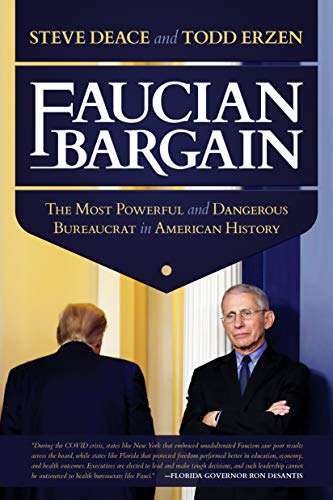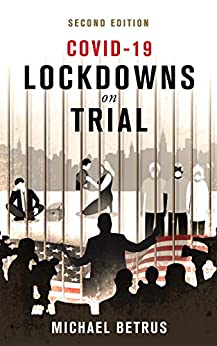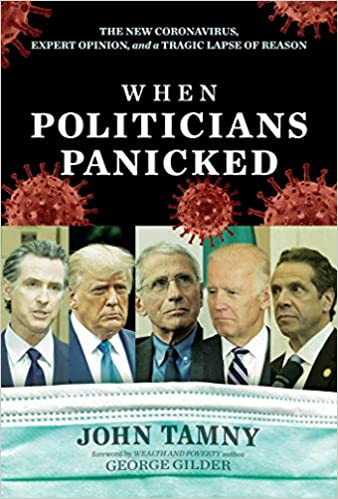
In the early days of the lockdown, Amazon experimented with curating which books they would and would not publish on the crisis. Or call it what it really is, given our times: censorship.
Among the first books hit was AIER’s own Coronavirus and Economic Crisis. The publication was delayed for weeks, then the Kindle edition was stopped for several more weeks. Still, the publication date is now listed as March 28, 2020, meaning that AIER had one of the first, if not the first, book out on the topic, just two weeks after the lockdowns began.
In the meantime, Amazon has loosened up, perhaps because the sales of a different point of view were potentially too lucrative to pass up. Indeed, I see many dozens of such books out there, all taking issue with the CDC’s narrative and the lockdown policy agenda. I’m thrilled by this. For that matter, AIER has published an additional four books on the topic, including my own Liberty or Lockdown.

I’ve been waiting for a bestseller, and it has arrived: Faucian Bargain: The Most Powerful and Dangerous Bureaucrat in American History by Steven Deace and Todd Erzen, two media commentators in the tradition of Rush Limbaugh.
This short book (it took me under an hour to read) is not strong on scientific rigor, but its sheer readability helps account for its huge seller status. Anyone who has lived and breathed the data, studies, and history pertaining to this terrible moment in history might find himself frustrated that the authors prioritize razzle-dazzle rhetoric and conservative-style talking points ahead of precision, citation, and calm exposition.
However, I don’t think our times permit that level of literary scrupulosity. The important point is that people are downloading and reading this in great numbers. This is good because the main storyline of the book is 100% correct. Not mincing words, they call this famous doctor “one of the most diabolical destroyers of self-governance and rugged individualism in all of American history.” It’s hard to disagree.
Dr. Anthony Fauci has played an outsized role in pushing lockdowns, disease panic, and flagrantly bad science via his major means of communication: interviews with sympathetic media on TV. Among many, he has obtained a godlike status but the authors show that he acts more as a political performance artist. Artists improvise, play roles depending on the need, and seek approval above all else. That’s their main complaint against him – his fawning for the camera, his changing lines, his pseudo-scientific and imprecise but seemingly impressive blather, and it is correct.
The authors draw attention to a huge mystery of his role early in the lockdowns. On February 28, he wrote in the New England Journal of Medicine that Covid-19 might “ultimately be more akin to those of a severe seasonal influenza.” On March 8, he told media that “there’s no reason to be walking around with a mask.” That was then, and, as they point out, he was mostly correct on these points in retrospect.
I will let the authors continue the story:
And now, we come to March 11. The day the earth stood still. The day our way of life ended, with no definitive hope of when it might return. For that is the day Fauci testified before Congress that COVID-19 would be “10 times more lethal than the seasonal flu.” This is the statement that sent shockwaves across the country and launched us into lockdowns…. what changed in those eleven days? What new piece of evidence or data did Fauci acquire to inspire such an about-face?
This is the crucial question. To be sure, there was already panic in the air on March 8, when South by Southwest was summarily shut down by the Austin, Texas mayor. There was talk of locking down everywhere, with the New York Times whipping up a big panic on its main podcast and op-Ed page. Even then, hardly anyone believed it would happen. That Fauci testimony was indeed the turning point. His whole demeanor seemed to be warning the assembled politicians that many of them will die. It was crazy stuff.
So what is our authors’ theory as to why he made the shift? They quote an anonymous White House employee who was there during the early days to the effect that Fauci became consumed by fame and celebrity. The more he called for lockdowns, the more panic he spread, the more he enjoyed the spotlight, and the more the media saw their ratings rise.
And let’s be real, the media loved every minute of it. It’s not just media bias, but the media ratings matter, too. They have to blow this up, focus on the fight back and forth, and make the virus into the Malaysian flight that CNN kept on and on with. It has to be all catastrophic all of the time, or people will make their own decisions and go about their lives. And if there’s anything the media in Washington cannot handle, it’s the average American making decisions in their lives without the supposedly valuable input. So Fauci feeds off the media, and the media feeds off of Fauci. Both of them clinging to each other to make both of them more relevant.
That sounds plausible. There is an additional problem raised by 300 pages of emails discovered via FOIA that detail Fauci’s own relationship with China. Even our authors, who cover the released emails, don’t seem entirely aware of the implications of a US delegation having travelled to China in mid-February to learn from Beijing the art of virus suppression. I cannot account for this myself. Why would Fauci step up to volunteer as our own Manchurian public health official? Why carry water for the CCP? At the age of 80, he surely is beyond being paid off or bribed or whatever. Did he really come to believe that China had the only way out? It all seems hard to believe.
Despite the pop feel, the obvious bias, the red meat from beginning to end, the authors are pointing to a dreadful scandal, and it is wholly understandable that this would inspire anger. Rightly so.

For a book with more data and evidence, in addition to a longer perspective on how free societies deal with pandemics, I would suggest Lockdowns on Trial by journalist Michael Betrus. The book came out in the summer but the 2nd edition came out in November 2020. The prose is elegant and mercifully calm. As I did in my book, he covers the policy response to previous lockdowns. He cites a huge amount of the literature showing a lack of any correlation between lockdown policies and disease mitigation.
The main merit of this book, in my view, is that it shows that in terms of pathogens and disease, these times have not been without precedent. We’ve been here before. Indeed, humanity has never not been here, with germs and so on floating and swirling all around us, many of them mutations of previous pathogens, all the while with our immune systems adapting and scaling to absorb them and fight them. With the exception of a few American cities in 1918, and only then for a brief time, this country has always dealt with infectious disease as a normal event to be handled by medical professionals, not an exceptional catastrophe to be managed by politicians and bureaucrats.
The burden of this book is to prove that these are in fact normal times or should have been regarded as normal times, which is to say that the mass panic was wholly unjustified. To that end, the book goes into some detail about the seemingly endless confusions over predictions, testing, data over infections and cases, and deals squarely with rampant issues of misclassification and exaggeration, the nursing home scandals, and also the details concerning demographic risk of SARS-CoV-2, the actual lethality of Covid-19 by age and comorbidities, and the deaths and how to count them.
Insofar as I am in a position to judge based on my own knowledge, I find this book highly credible in addition to readable, with mercifully little in the way of politicized argumentation. Most impressive among these books, the author deals with the astonishing costs of lockdowns, which are not only economic but also social, cultural, and medical. Remarkably, lockdowns performed in the name of public health have in fact devastated public health.
The book includes detailed debunkings of hundreds of media-touted myths of superspreader events, surges, outbreaks, spread in restaurants and bars, in addition to bringing all of this in focus with a proper emphasis on severe outcomes rather than cases as such.
Other issues covered here: media bias, censorship, masks and their (lack of) effectiveness, the complete absence of evidence of some relationship between lockdowns and disease outcomes, and the outlying states around the world with no lockdowns and excellent outcomes. The chapters on suicides, drug overdoses, depression, learning loss, missed treatments, weight gain, business closures, and more terrible things, are enormously depressing and hard to read. Indeed, I’m hard-pressed to think of a single issue of note not covered in this book.
The book has a conclusion I like: the lockdowns did not do what they were supposed to do, they caused unspeakable collateral damage, and therefore should be lifted everywhere immediately.
I do have one argument with the author: I do not agree that stopping flights from China and Europe was a good idea, even with the information we had at the time. The presumption always should be about the freedom to travel. There are no ways to do counterfactuals here but the virus was already in the US, so I seriously doubt that these blocks achieved anything in terms of public health. Plus, they violate human rights.
Day to day, my number one major annoyance in life – okay maybe not the whole of life but certainly my annoyance with the media – is the way in which terrible outcomes of lockdowns are frequently attributed to the “pandemic.” At the New York Times, this is daily prattle, almost assuredly imposed by editors. Writers can pen stories about depression, job loss, crisis in industries, disrupted supply chains, hunger and suffering, and everything else, so long as the causal agent is always named as the pandemic. The lockdowns, goes the implication, were just what one has to do in the presence of the new pathogen.

This is why I absolutely adore John Tamny’s fabulous book When Politicians Panicked. It doesn’t cover cell biology, death and case data, PCR testing scandals, hospitalizations, or virus trajectories at all. It keeps the focus on what really matters: how politicians smashed our economic lives out of a complete panic of what else to do. “To blame this on the coronavirus is to excuse ineptitude that is the normal when the combined, decentralized knowledge of millions and billions of humans is ignored in favor of the central and highly limited knowledge of a very few politicians, and even fewer experts.”
Tamny proves decisively that lockdowns were the cause of the crushed economy that was otherwise healthy, and this did not have to be. His fascinating spin on the China issue will challenge any reader. He points out that the market signals coming out of China even in the worst days of the pandemic were in fact not revealing anything terribly disruptive in terms of disease outcomes. US companies in China tested their employees and found few cases and no deaths. No American company with a deep stake in Wuhan was showing any level of market response to the pandemic. Tamny watches these markets carefully and concluded early on, by virtue of the information they were providing, that this virus itself represented minimal if any threat at all to social and economic functioning. Its severe outcomes were limited to the health and well-being of a small demographic and that would be treated medically and not politically.
The reason this did not happen is the core thesis of the book. The politicians panicked. Lockdowns became the default response, though they had never been tried before, and a test of leadership grit. Real men and real women lock down to control the virus! That was the ethos stemming from panic. “What happened was an imposition of command-and-control that has always suffocated economic growth.” Tamny further shows that economic growth has always been a precondition for good health outcomes, so it makes no sense at all to shut it down. He will not call what resulted a recession, on grounds that this would be insulting to a very natural market process. It was pure destruction, and pointlessly so, since the virus should always have been treated as a medical matter.
The book excels – and is thus far singular – in addressing the complete failure of the various stimulus packages intended to substitute for a functioning economy. It can never work. Whether the stimulus is fiscal or monetary, the government can only take from the private sector and redistribute it but it can never make up for losses associated with lockdowns. The author is right on target in associating this with Khrushchev-style economics (I thought that was my original insight; Tamny had it first). The Soviet dictator imagined that governments could outperform markets in a way that made markets irrelevant and unnecessary, exactly as the lockdowners thought that government could easily.
Tamny’s book succeeds mightily in intellectually crushing the lockdown deniers (people who pretend like it never happened), and for that reason it is enormously satisfying. Somehow out of the three books mentioned here, this is the one that is most heartbreaking and most maddening since it shows decisively that none of this was necessary. None of it. The lockdowns were a monumental distraction from the job that needed to be done, and which always needs to be done, which is to promote good health outcomes.
Tamny is willing to ask unaskable questions such as: what if the politicians had done nothing? His answer might shock anyone who has yet to rethink the tragic events of the last year. He says we would have been better off and the severe outcomes from the disease better because of the nursing home scandals and the collateral damage. In other words, the “mitigation” efforts not only wrecked the economy; they wrecked public health too.
I’m so grateful to John Tamny for writing this book, which says exactly what needs to be said, and ends just the right way: it is time to reassert the primacy of freedom.
These are three of what will be thousands of books that will be appearing in the coming years on these tragic times. I’m willing to wager that most of these books will severely condemn the policy decisions of the last year, just as these have done. There will be a reckoning. These books are an excellent start.
* This article was originally published here
HELP STOP THE SPREAD OF FAKE NEWS!
SHARE our articles and like our Facebook page and follow us on Twitter!





0 Comments